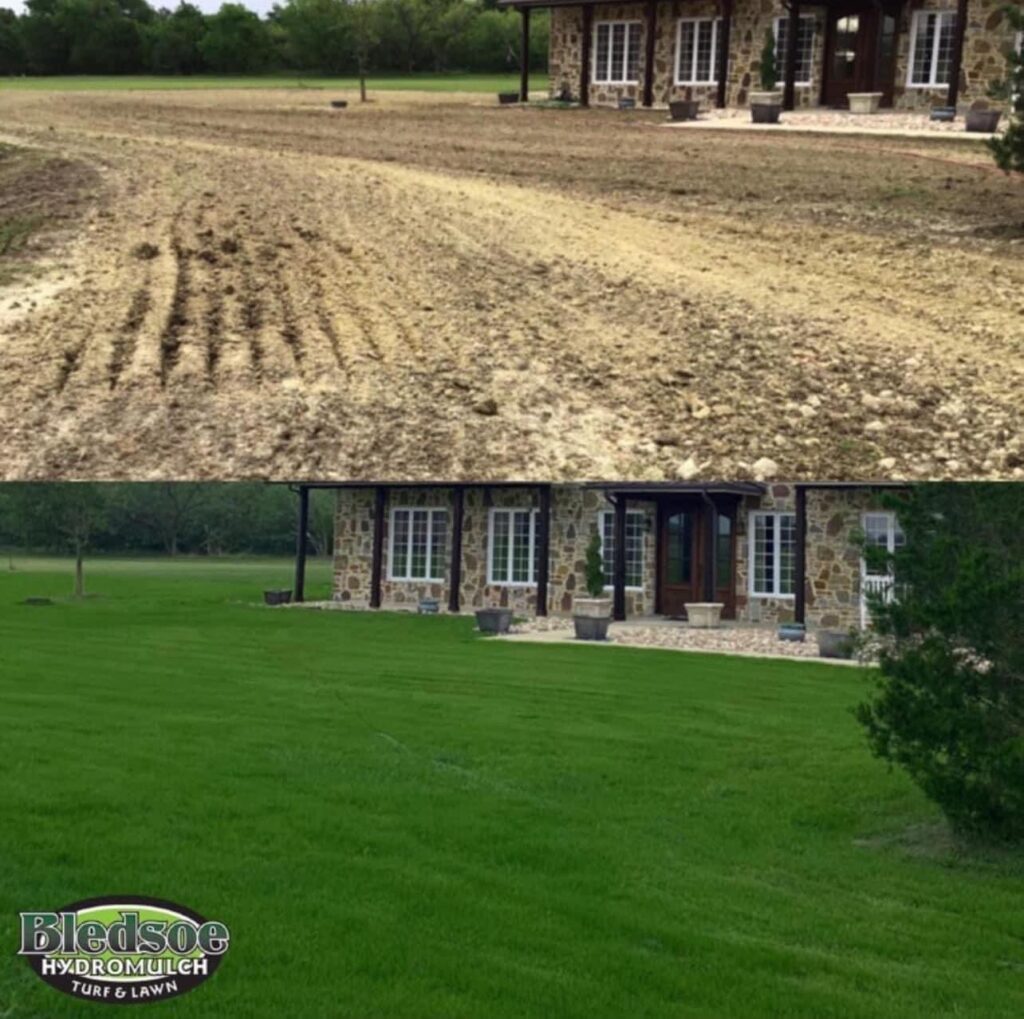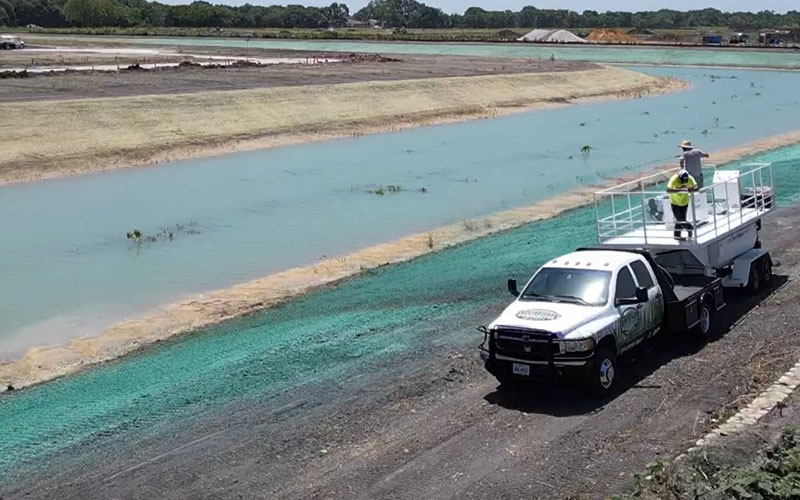Soil erosion is a natural process, but human activities and environmental factors can accelerate it, leading to significant landscape damage, decreased soil fertility, and environmental concerns like sedimentation in waterways. For property owners, especially those with slopes or areas prone to runoff, controlling erosion is essential for maintaining a healthy and attractive landscape. Hydromulching has emerged as an effective solution for erosion control, offering both immediate and long-term benefits. In this blog post, we’ll explore how hydromulching helps prevent soil erosion and why it’s an ideal choice for safeguarding your property.
Understanding Soil Erosion
What Causes Soil Erosion?
- Water Runoff: Heavy rainfall or irrigation can cause surface runoff, dislodging soil particles and carrying them away.
- Wind: In arid or exposed areas, wind can blow loose soil particles, leading to erosion.
- Gravity: On slopes and hillsides, gravity can cause soil to move downward, especially when the soil is saturated with water.
Consequences of Erosion
- Landscape Degradation: Loss of topsoil affects plant growth and can lead to unsightly gullies and bare spots.
- Environmental Impact: Sedimentation in rivers and lakes can harm aquatic life and degrade water quality.
- Structural Damage: Erosion near foundations, roads, or other structures can compromise their integrity.
How Hydromulching Mitigates Erosion
Hydromulching is more than just a method for planting seeds—it’s a comprehensive erosion control strategy. Here’s how it works:
1. Immediate Soil Stabilization
Protective Mulch Layer
- Mulch Composition: The hydromulch slurry contains mulch made from wood fibers or recycled paper, which forms a cohesive blanket over the soil.
- Erosion Barrier: This mulch layer shields the soil surface from the direct impact of raindrops and irrigation, reducing the displacement of soil particles.
- Wind Resistance: The mulch binds to the soil, making it less susceptible to wind erosion.
2. Enhanced Seed Germination and Vegetation Growth
Rapid Vegetative Cover
- Fast Germination: Hydromulching creates an optimal environment for seeds to germinate quickly due to retained moisture and nutrients.
- Root Establishment: As plants grow, their roots anchor into the soil, providing natural reinforcement against erosion.
- Vegetative Mat: A dense cover of grass or plants further protects the soil from erosion agents.
3. Use of Tackifiers and Binders
Increased Adhesion
- Tackifiers: These are natural or synthetic sticky substances added to the hydromulch mixture.
- Soil Binding: Tackifiers help the mulch and soil particles adhere to each other, forming a stable matrix that resists erosion.
- Longevity: The binding effect lasts long enough for vegetation to establish and take over the role of erosion control.
4. Adaptability to Slopes and Difficult Terrain
Effective on Inclines
- Uniform Application: Hydromulching can be sprayed evenly over slopes, ensuring complete coverage.
- Erosion Control on Slopes: The mulch layer prevents runoff from gaining momentum, reducing the potential for rill and gully formation.
- Accessibility: Equipment can reach areas that are challenging for traditional erosion control methods.

Advantages Over Traditional Erosion Control Methods
Hydromulching vs. Erosion Control Blankets
- Installation Efficiency: Hydromulching is faster to apply and conforms to the terrain without the need for staking or anchoring.
- Seed Incorporation: Seeds are included in the hydromulch mixture, whereas erosion control blankets often require separate seeding.
- Cost-Effective: Lower labor and material costs make hydromulching a more economical choice.
Hydromulching vs. Silt Fences and Wattles
- Comprehensive Protection: While silt fences and wattles only control sediment after erosion has occurred, hydromulching prevents erosion at the source.
- Aesthetic Appeal: Hydromulching promotes vegetation growth, enhancing the visual appeal of the landscape.
Long-Term Environmental Benefits
Soil Health Improvement
- Organic Matter: As the mulch decomposes, it adds organic matter to the soil, improving fertility and structure.
- Microbial Activity: Enhanced soil conditions support beneficial microorganisms that contribute to soil stability.
Water Quality Protection
- Sediment Reduction: By preventing soil erosion, hydromulching minimizes sedimentation in nearby waterways.
- Pollutant Filtration: Vegetative cover acts as a natural filter, trapping pollutants before they enter the water system.
Habitat Creation
- Biodiversity: Establishing vegetation provides habitats for insects, birds, and other wildlife, promoting ecological balance.
- Native Species Support: Hydromulching can incorporate native plant seeds, supporting local ecosystems.
Case Studies: Hydromulching in Action
Residential Slope Stabilization
- Challenge: A homeowner faced severe erosion on a steep backyard slope, leading to soil loss and landscaping issues.
- Solution: Bledsoe Hydromulch applied a custom hydromulch mixture with a robust tackifier.
- Result: Rapid vegetation growth stabilized the slope, eliminated erosion, and enhanced the property’s aesthetic appeal.
Commercial Development Site
- Challenge: A construction site needed immediate erosion control to comply with environmental regulations and prevent sediment runoff.
- Solution: Hydromulching provided quick coverage over exposed soil areas.
- Result: The site remained in compliance, and vegetation established quickly, reducing dust and improving site appearance.
Best Practices for Maximizing Erosion Control with Hydromulching
Proper Site Preparation
- Soil Testing: Identify soil conditions to select appropriate seed mixes and soil amendments.
- Debris Removal: Clear the area of rocks, roots, and other obstacles to ensure effective application.
Quality Materials
- Select High-Quality Mulch: Using premium mulch fibers improves the protective layer’s effectiveness.
- Effective Tackifiers: Choose suitable binders based on site conditions, especially for steep slopes.
Professional Application
- Experienced Technicians: Skilled application ensures uniform coverage and optimal results.
- Customized Solutions: Tailoring the hydromulch mixture to specific site needs enhances erosion control.
Follow-Up Care
- Watering Schedule: Maintain appropriate moisture levels to encourage vegetation growth.
- Monitoring: Regularly inspect the site for any signs of erosion or issues that need addressing.
Conclusion
Erosion control is a critical aspect of landscape management, particularly for areas with challenging terrains or environmental sensitivities. Hydromulching offers an effective, efficient, and eco-friendly solution to prevent soil erosion while promoting healthy vegetation growth. By forming a protective barrier, enhancing seed germination, and stabilizing the soil, hydromulching safeguards your landscape against the damaging effects of erosion.
Protect Your Landscape with Bledsoe Hydromulch
At Bledsoe Hydromulch, we specialize in erosion control solutions tailored to your property’s unique needs. Our expert team uses high-quality materials and proven techniques to ensure your landscape remains beautiful and resilient.
Contact us today at (214) 784-5402 or email [email protected] to schedule a consultation. Let us help you protect and enhance your property with our professional hydromulching services.
Bledsoe Hydromulch—Your Partner in Sustainable Erosion Control and Vibrant Landscapes.
